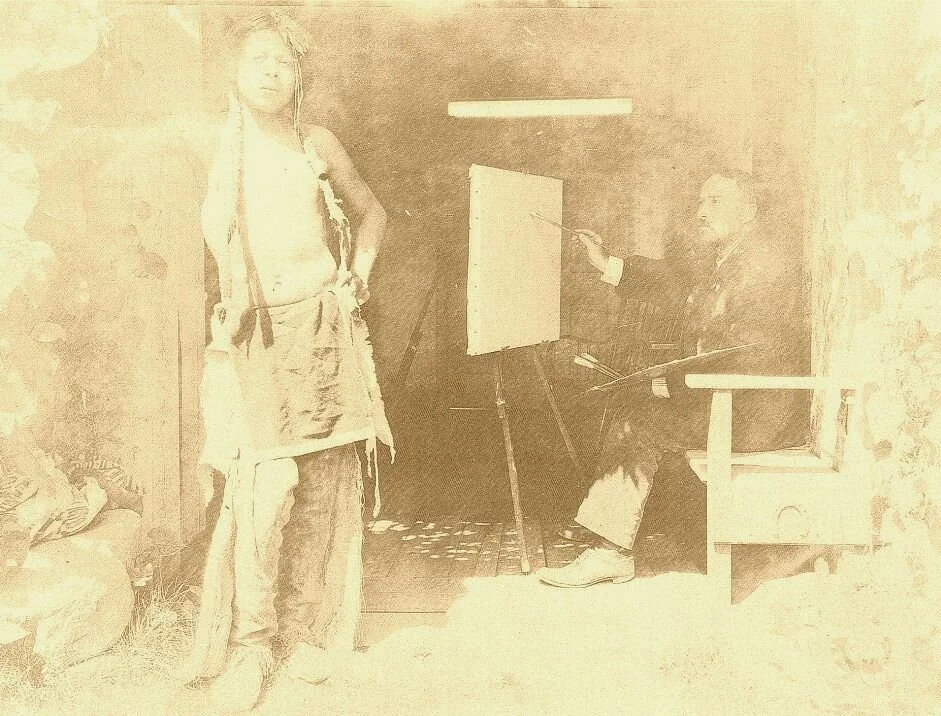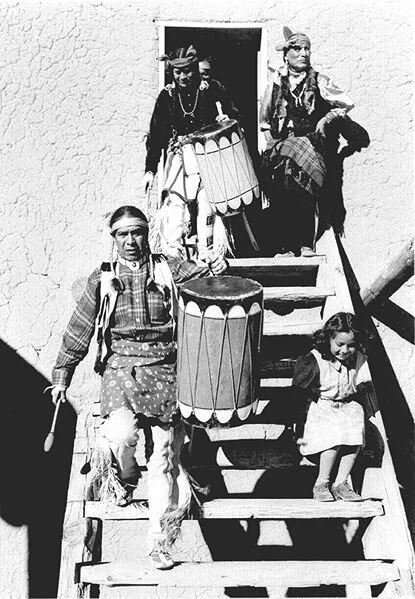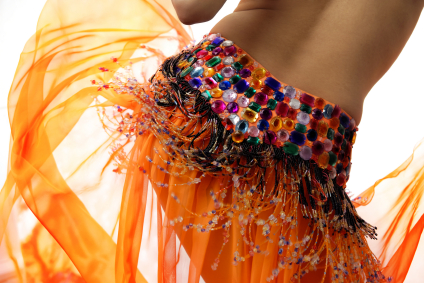 It was a given that I would be the only male in the weekly belly dancing class that I took off and on for years. Being a gay man, you would think that I would be put off by the incredible lack of testosterone. It actually was a blessing because I didn’t have the distraction of watching gorgeous men moving their muscular bodies. Therefore, I paid closer attention to the instructor and learned how to do the many tribal movements with grace and ease. Who knew that eventually I would get the chance to wiggle my hips in a far away, exotic land.
It was a given that I would be the only male in the weekly belly dancing class that I took off and on for years. Being a gay man, you would think that I would be put off by the incredible lack of testosterone. It actually was a blessing because I didn’t have the distraction of watching gorgeous men moving their muscular bodies. Therefore, I paid closer attention to the instructor and learned how to do the many tribal movements with grace and ease. Who knew that eventually I would get the chance to wiggle my hips in a far away, exotic land.
All in Art and Culture
Fat and Happy
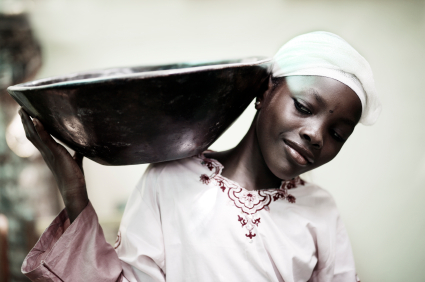 “Promise you will stay one more year. We are so happy with how you relate to us. And you are happy, yes? You are getting fat.” Looking at Mama Ami, I know she is quite serious. How would she know that where I come from, being called fat isn’t exactly a compliment? My mind jumps full speed into a rapid analysis of how much I may have changed in the months since my arrival in Nigeria – a diet primarily of okra or bitter green soups with starchy porridges; the occasional dish with beans and crayfish but general deficiency of good protein; the dearth of fresh produce in our market, the lack of refrigeration and my waning interest in learning the labor intensive traditional methods of preparing their dishes – anything was possible. Snapping out of it, I let myself simply feel pleased that they are comfortable with my presence.
“Promise you will stay one more year. We are so happy with how you relate to us. And you are happy, yes? You are getting fat.” Looking at Mama Ami, I know she is quite serious. How would she know that where I come from, being called fat isn’t exactly a compliment? My mind jumps full speed into a rapid analysis of how much I may have changed in the months since my arrival in Nigeria – a diet primarily of okra or bitter green soups with starchy porridges; the occasional dish with beans and crayfish but general deficiency of good protein; the dearth of fresh produce in our market, the lack of refrigeration and my waning interest in learning the labor intensive traditional methods of preparing their dishes – anything was possible. Snapping out of it, I let myself simply feel pleased that they are comfortable with my presence.
Truthfully, I wasn’t sure how comfortable I would be here – a country of over 200 different ethnic groups, a mixture of Muslims and Christians, an international image well ensconced in corruption and scams. But here I was, living in a small town, working for a local organization whose office was housed on the family compound. The business’ fish tanks and hatchery edged one side of a large dirt yard otherwise surrounded by the homes of the cousins, their families, and the elder mamas. Sitting on the porch with Mama Ami and her husband Joshua, I know she is right - I am happy. The contentment has been unfolding so slowly I barely noticed it; made up of hundreds of tiny milestones of recognition and inclusion.
Thailand is renowned for having some of the world’s best prostitutes.
It also has some of the scariest.
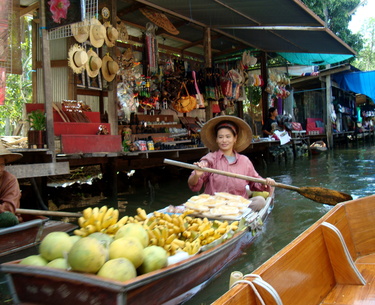 My first order of business upon arriving in Bangkok was an early morning trek to the Damnernsaduak Floating Market, a 90 minute drive south of town in light traffic, and one of the most fascinating places I’ve ever been.
My first order of business upon arriving in Bangkok was an early morning trek to the Damnernsaduak Floating Market, a 90 minute drive south of town in light traffic, and one of the most fascinating places I’ve ever been.
The Damnernsaduak Floating Market is a series of canals lined by rickety wooden stalls selling all manner of goods, from tacky tourist items to local art and sculptures. You can purchase exotic spices and oils, native clothing, a vast array of fresh fruits, and even play with snakes.
When you arrive at Damnernsaduak you hire one of the long-tailed wooden boats to guide you through the markets. A 2-hour tour is around 300 Bhat (about $9), and the boatman will just float along past shops til one peaks your interest and you ask him to pull up alongside. There are also numerous merchants in other boats selling fresh fruits, meats, or cool drinks. They’ll pull up beside your boat to pour you hot tea, show off their fruits, or describe (always in a language I don’t understand) what their meat on the stick is and why you must buy it.
In the middle of the market is a non-descript shack that at first glance appears to be selling nothing. There are a couple of guys lounging in chairs enjoying a smoke. Upon closer inspection you discover that the men are draped in huge snakes, and are all too eager to show them off to interested tourists.
I can’t resist bad decisions like this, so of course I stopped.
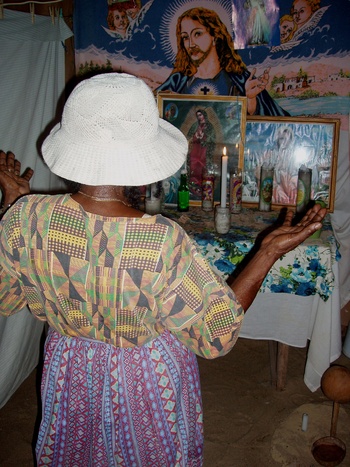 Garifuna healer, Erdangela Polonio. Buyei, Belize. Picture this. The large thatched-roof, sand-carpeted temple was barren except for the obviously ill child curled up in the single cot by the wall. An old woman could be heard chanting from within her sacred chamber, candlelight flickering around the corners of the sheet separating her from the long hall. Her healing incantations, I later discovered, were addressed to the spirits who may have had reasons of their own to inflict the child.
Garifuna healer, Erdangela Polonio. Buyei, Belize. Picture this. The large thatched-roof, sand-carpeted temple was barren except for the obviously ill child curled up in the single cot by the wall. An old woman could be heard chanting from within her sacred chamber, candlelight flickering around the corners of the sheet separating her from the long hall. Her healing incantations, I later discovered, were addressed to the spirits who may have had reasons of their own to inflict the child.
Intrigued? Okay, here’s the story. Spirits are big in the Garifuna community of Belize -- which by the way is a Central American country that thinks it’s a Caribbean island. Garifuna, you say? Never heard of them. Part of the melting pot civilization which comprises Belize, the Garifuna share the land with Creole, Mayan, Spanish, Mennonite, Chinese and other neighbors but their language, customs, foods and religion are unique. So are their spirits.
Now there are only about 7000 Garifuna currently in the country, but the spiritual population is a lot larger. “Our ancestors are all about us,” Lawrence, our guide, told me: “Just as we must eat and drink to live, so must they be nourished as well.” This is something the ancestors take very seriously.
So if they perceive they are being neglected, the dead return, most often through dreams, to remind the living that they are in need of nourishment. If this message goes unheeded, the spirits may get angry and make a family member sick. The ancestors do not take kindly to being ignored.
I adore postcards. But I can’t remember the last time I received one – can you? Probably sometime around the mid-1990’s, just before email sucked the life out of stamps.
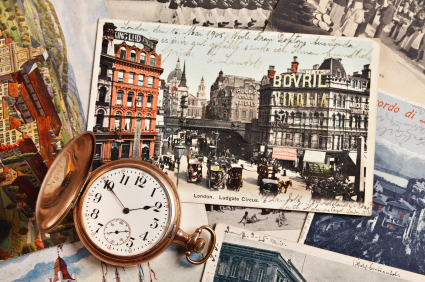 It seems that, while I wasn’t looking, sending postcards went out of style. Well, let’s face it – everything does, eventually. But it hit home this past holiday season, when assorted friends took off for Australia, New Zealand, Guatemala, Spain and Dubai – and the mailman never delivered a single card to me.
It seems that, while I wasn’t looking, sending postcards went out of style. Well, let’s face it – everything does, eventually. But it hit home this past holiday season, when assorted friends took off for Australia, New Zealand, Guatemala, Spain and Dubai – and the mailman never delivered a single card to me.
Am I the only one who loved to send them? Most people are quite happy to receive one in the mail, but a particular joy of mine while traveling has always been to spin those metal racks in the tourist shop and study various options in order to find the perfect photograph for each individual on my list. (Mount Fuji for the climbing buddy, Kyoto cherry blossoms for my gardening pal, the Uwa Jima Pornography Museum for….well, never mind.) I would send postcards to everyone; friends, co-workers and neighbors. Including some folks I would never consider writing to otherwise, but now wished to impress with my fabulous life exploring exotic places, while they never got farther than their mailboxes.
Turning Japanese
“No photos with coat,” she instructs my photographer husband with a smile. The petit, pigeon toed, doll-like figure clad in a silky red, black and white kimono is ever so polite but adamant about him not taking any photos of me while I am wearing the box-shaped overcoat.
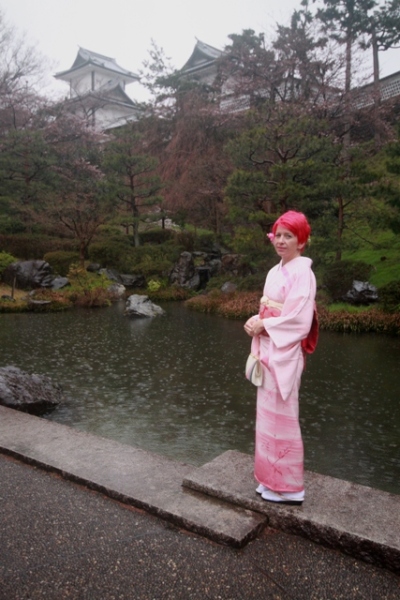 Photos in the kimono are allowed and encouraged but almost forbidden if the kimono-clad woman is wearing an overcoat. I bow slightly and smile while nodding affirmatively. I feel and look like a modern version of an obedient Japanese woman.
Photos in the kimono are allowed and encouraged but almost forbidden if the kimono-clad woman is wearing an overcoat. I bow slightly and smile while nodding affirmatively. I feel and look like a modern version of an obedient Japanese woman.
It’s my 40th birthday and I’m about to hit the streets of Kanazawa, the small castle city on Japan’s main island of Honshu that is northwest of Osaka. I am a bit nervous to be going out amongst the Japanese people: a Westerner with pink hair wearing the beloved kimono.
So you probably want to know what I am doing in the kimono under an overcoat in Japan, and who says I can't be photographed in an overcoat. Actually, it started two hours ago. When I arrive for my one o'clock appointment, I notice the foyer is lined wall to wall with shoes and slippers, like many Japanese households. It is customary to remove footwear and swap your shoes for a pair of slippers before entering.
Haruka, the young owner of the kimono rental shop greets us with many bows and the familiar “Irrashimasse” (welcome), a word that is used by many shopkeepers as you enter their shops or to entice you to enter their shops.
We duck through the noren (door covering), and enter the main sitting area. A low set table with red cushions as seats is in the middle of the room. Pictures of kimono-wearing woman, mostly Japanese, adorn the shelves and table tops.
Haruka shuffles through the paper-panelled sliding doors and disappears up a dark staircase. I follow her, using my hands to climb my way up the steep passageway. The room at the top is bright and airy. This is where the kimonos live.
The shelves are covered with delicate fabrics and laid out in color–coded piles. Haruka points out which ones are for springtime--pastel pinks, soft blues, yellows and purples; some with delicate features or intricate designs lie before me. I’m drawn to the pinks.
I choose a soft, pink silk kimono that gradually darkens as the material reaches the calf area. The fabric is designed with sporadic branches and leaves, similar to sakura (cherry blossom). I feel like a little girl playing dress-up.
Searching for Sunrise in a Megalithic Cemetery, Ireland
Cautiously, my husband Gary, our friend Michael, and I followed a nearly invisible path through the fog and up the side of Loughcrew hill, just before sunrise. A huge crow—perhaps a raven—flew by, its wings flapping loudly in semi-darkness. We were heading to the ridge top to see a twice-a-year spectacle: the rays of the equinox sunrise penetrating the passageway of Cairn T, a 5,500-year-old megalithic tomb situated 52 miles northwest of Dublin. The equinoxes, which occur around March 21 and September 21, are the two times of the year when the days and nights are of equal length.
It started out with a scant breakfast (have you ever tried a one egg omelet?) and miles of walking around the city streets of Quito in Ecuador wearing wedged sandals instead of sneakers. Wedged sandals are not the shoes of choice when traveling. My feet, already aching, were really in a state of extreme protest, a not too subtle indication of the agony to come. We were on our way to visit the art exhibit we’d been anticipating all day, but hadn’t quite left any time out for either lunch or water.
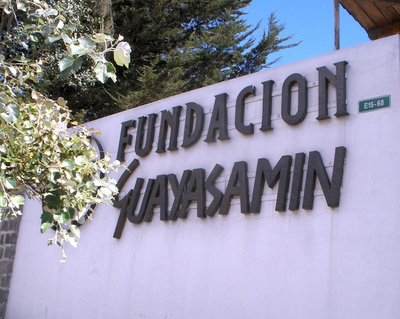 The Guayasamin Museum was our destination and surpassed all our expectations. The paintings and sculpture were impressive and the house in which they were displayed, splendidly representative of the Ecuadorian painter’s era (1919-1999). The original house had an extensive collection of pre-Columbian art he had acquired over decades. The only downside was that there was no place to eat! Our dilemma was if we were to start searching for a restaurant, there wouldn’t be time to get to Guayasamin’s Capilla del Hombre (The Chapel of Man), which was a “must.” By now it was a toss-up as to which was worse, my overwhelming hunger or my throbbing feet.
The Guayasamin Museum was our destination and surpassed all our expectations. The paintings and sculpture were impressive and the house in which they were displayed, splendidly representative of the Ecuadorian painter’s era (1919-1999). The original house had an extensive collection of pre-Columbian art he had acquired over decades. The only downside was that there was no place to eat! Our dilemma was if we were to start searching for a restaurant, there wouldn’t be time to get to Guayasamin’s Capilla del Hombre (The Chapel of Man), which was a “must.” By now it was a toss-up as to which was worse, my overwhelming hunger or my throbbing feet.
We decided to skip the restaurant search and walk to the Capilla which, we were assured, was just a short distance away. We simply couldn’t take a chance on missing the experience of visiting this most amazing structure, Oswaldo Guayasamin’s final dream, completed three years after his death as a tribute to the 500-year struggle of indigenous people of the continent.
words + photos by Jolandi Steven
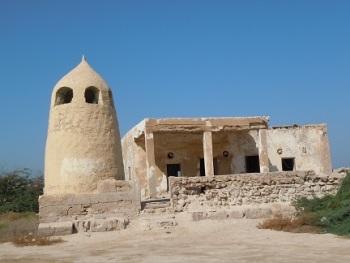 In the pursuit of progress, the past is often overlooked, neglected, discarded or forgotten.
In the pursuit of progress, the past is often overlooked, neglected, discarded or forgotten.
But to me, it holds an allure that is enticing, charming, mesmerizing and utterly seductive. Not so for everyone: When I first mentioned the abandoned village of Al Jazirah Al Hamra on the outskirts of Ras-al-Khaimah in the United Arab Emirates to my husband, he evinced his non-committal with a shrug of his shoulders.
Thanks to Google, I learned that Al Jazirah Al Hamra means “Red Island,” and before the discovery of oil and subsequent land reclamation that linked the old town permanently to the mainland, it was on a peninsula that, with high tide, became an island. The questions puzzling me were: “Why did the people abandon their homes?” “Where did they go?”
CHIAPAS, MEXICO: Maya, Mother Nature, and More.
Discover Chiapas, Mexico, through three unique perspectives. Judith Fein explores Maya ruins, culture, and traditions with archaeologist Yolanda Ruanova, uncovering the ancient and contemporary Maya world. Photographer Paul Ross captures the faces and landscapes of Chiapas. Ellen Barone embarks on a backcountry equestrian adventure with Enduro Ecuestre. Experience history, culture, and adventure in Mexico’s hidden gem.
Traveling Back Through Time in Taos
Although Starr Interiors, the gallery that I’ve had for decades, has been housed in what was once the home of one of the founding artists of Taos, New Mexico, E.I. Couse, only recently have I gotten entranced with the history of the building. I’ve known about it, but it’s always been in the abstract. My deed was signed under the presidency of Abraham Lincoln, but the building which was originally constructed as a private home, existed long before that. I’d never given much thought to the previous owners and the part they played in the colorful history of Taos.
Since making a connection with Virginia Couse and her husband, Ernie Levitt, who have the Couse Foundation, I’ve become inspired to do some of my own research into this historic building. They’ve been good enough to provide us with some photos when Virginia’s grandfather and his wife, the first Virginia, lived in the house, from 1906-1909, calling it Las Golondrinas. It was there that her grandfather built his studio by opening up the roof and adding on what looked like a greenhouse to provide him with the northern light he needed to paint by.
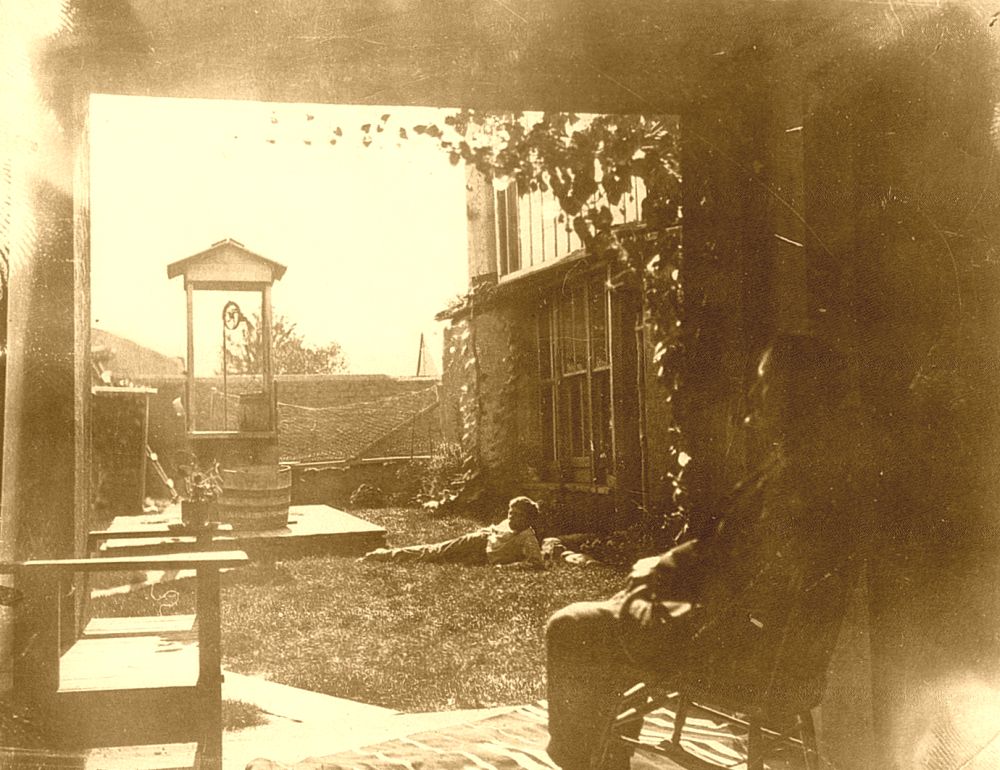
He also often painted in the courtyard. This courtyard was beautiful then, as now, and a photograph caoturs Couse sitting in the doorway at his easel with a handsome young model from the Pueblo standing in front of him. In another, we see him sitting in the courtyard on one of the rocking chairs with his wife stretched out on the grass, hollyhocks and Virginia creepers lining the sides of the courtyard.
words + photos by Rachel Dickinson
This summer while on a pilgrimage of sorts to Germany to see several Women’s World Cup soccer matches, I stumbled across something that kept me dipping into every cathedral in every town I visited. I discovered the appeal of the relic.
Seven Years Younger: Life On Ethiopia Time
words + photos by Maureen Magee
Time zones, the International Date Line and jet lag all contribute to my feeling disoriented when traveling. Date lines especially – leaving home on a Tuesday and arriving on the Monday before I left definitely throws me for a loop.
 But what about when the traveler leaves home in 2011 and arrives in 2004?
But what about when the traveler leaves home in 2011 and arrives in 2004?
It happens all the time – when traveling to Ethiopia. Once you disembark in Addis Ababa, you will be at least 7 years younger.
My first trip to this time-estranged nation was in September, 1999. The airport was festively decked out with banners proclaiming some kind of celebration, followed by “1993!” I couldn’t speak or read Amharic, so the actual celebration was a mystery – but I figured it must have been a heck of an important party, if Ethiopians left the banners up for 7 years.
My guide greeted me with a standard “Hello”, followed by a joyous “Happy New Year!” After 24 hours in transit, I was too tired to question this and thought, who knows – maybe in Ethiopia, everyone is welcomed with a New Years greeting – even if it is 9 months later. One never knows in other cultures…
by Eric Lucas
Hardly anything seems secret about a kernel of blue corn. It’s the size and shape of a baby’s tooth, the indigo color of ocean dusk, not rock-hard but sturdy, like old pine.
Such a seed would be a secret, were it a product of American industrial agriculture—patented, engineered at a molecular level, sold under some trade name like Blue 7X-RR. You would pay a large Midwestern company to have some; you’d use huge machines like science fiction robots to lay it in the ground; pour on it chemicals with carbon-chain formulas as long as Finnish words; autoclave it into foods as artificial as plastic. And you’d get your pants sued off if you attempted to replicate it or reproduce it in any way.
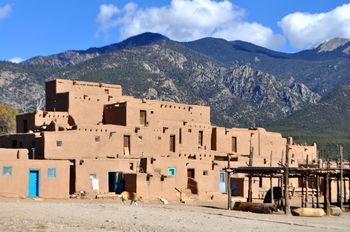 Photo by Manya Kaczkowski, 2010But the handful of blue corn seeds I’m holding represent a gift from, first of all, Robert Mirabal, a Taos Pueblo resident; also a gift from two millennia and the ground on which a billion people live. Corn is the bedrock of civilization in the Western Hemisphere. It built a dozen empires in Mexico and South America; helped create two dozen thriving cities in the desert Southwest about which Spanish explorers marveled so much that their colonizer, Don Juan de Oñate, declared his conquest a “kingdom.” Nuevo Mexico; it’s called New Mexico now, but still part of the kingdom of corn. And the seeds Mirabal has given me are no secret, just gifts from that kingdom’s treasure.
Photo by Manya Kaczkowski, 2010But the handful of blue corn seeds I’m holding represent a gift from, first of all, Robert Mirabal, a Taos Pueblo resident; also a gift from two millennia and the ground on which a billion people live. Corn is the bedrock of civilization in the Western Hemisphere. It built a dozen empires in Mexico and South America; helped create two dozen thriving cities in the desert Southwest about which Spanish explorers marveled so much that their colonizer, Don Juan de Oñate, declared his conquest a “kingdom.” Nuevo Mexico; it’s called New Mexico now, but still part of the kingdom of corn. And the seeds Mirabal has given me are no secret, just gifts from that kingdom’s treasure.
Discover the Exotic on a Road Trip
“None of your business,” she said. The short, curly, white hair bounced as she shook her head, but the brown eyes smiled in her beautiful, tanned and weathered face. Half Navajo, Suzie (not her real name) has lived in Rio Grand pueblos in New Mexico all her life. We were sitting in a rambling adobe house near the village where she lives with her husband. Grandchildren and daughters dropped in from time to time as we talked. The smell of cedarwood smoke curled around us, and tin-framed pictures of saints glinted on the walls.
by Judith Fein
I wish I could climb into a time machine and be catapulted back to the Viking period between 793 and 1066 A.D. I don’t care for the raiding and pillaging but I have been to L’Anse Aux Meadows in Newfoundland twice (the only authenticated Viking site in North America), I have held my breath as I read the Iceland sagas, and I know these hunting and planting people were resilient, artistic and resourceful; the women had power and prestige, and their governance was of the democratic variety. They wrote on rune stones, were brilliant ship builders and goldsmiths. They drank mead from horns, braved the cold and produced mighty sorcerers.
Photo Slide Show by Paul Ross
Last month, I went to Norway on the trail of the Vikings; actually, I felt as though I were in Viking school. At the archeological museum in Stavanger, I learned that the Vikings probably practiced a form of yoga and that diverse elements in nature like swimming birds and halibut were thought to help the sun on its daily journey. They believed in night ships that went into the water and the dark earth at night, and day ships that came up again in daytime.
words + photos by John Lamkin
Cora Amalia, the president of the municipality, affirmed the stories I’d heard for a while. There was a “lost” Maya city in the nearby jungle that rivals Tikal in Guatemala and has a pyramid larger than the one at Palenque in the state of Campeche.
“When can I go there?" I asked the government tourism officials. “Only when you get permission from INAH (Instituto Nacional de Antropología e Historia),” was the answer, “And you can’t go now because the jungle roads are too muddy. You must wait for the dry season.”
 Well, the dry season came. We applied for and got the INAH permit and set off on the adventure – seven of us in Luis’ Suburban.
Well, the dry season came. We applied for and got the INAH permit and set off on the adventure – seven of us in Luis’ Suburban.
Our crew consisted of Luis Tellez, professional guide and photographer and his wife Leti, myself and my significant other Susy, two expats that lived locally and had done some research on the city, and don Millon a 90-year-old farmer who had worked in the area as a chiclero, one of the men that harvested the chicle for making chewing gum, and who had visited the ruins in his youth.
We located the turn-off from the paved road that led to a small Maya community of a few traditional thatched huts. We presented our permit to a Maya woman who was the designated caretaker. She read the permit and then herded her family out to be photographed by us.
by Judith Fein
[more from our SPOTLIGHT ON PORTUGAL series this week... ]
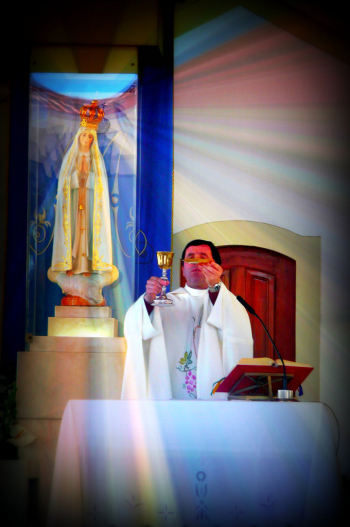 photo by erin-thérèse via flickr (common license)Do you believe in miracles? How else can you account for what happened in a field in central Portugal on May 13, 1917, when three shepherd children saw a vision of the Virgin Mary? Purportedly, she told the awe-struck kids that she would appear at the same spot on the l3th of the five following consecutive months. According to believers, up to 70,000 witnesses beheld a miraculous apparition on the 13th day of the last month. Go to Fatima yourself to see if you are uplifted, transported, or merely interested. It’s about one and a half hours from Lisbon by train. The three children are buried in the sanctuary, and in one outdoor area the faithful light long beeswax candles that intertwine as they melt and carry prayers to heaven. Be sure to visit the museum, where Marians from around the world—including Pope John Paul—have left objects that are precious and significant to them. The latter even donated the bullet that was used by the man who tried to assassinate him. He believed that the Virgin of Fatima saved him.
photo by erin-thérèse via flickr (common license)Do you believe in miracles? How else can you account for what happened in a field in central Portugal on May 13, 1917, when three shepherd children saw a vision of the Virgin Mary? Purportedly, she told the awe-struck kids that she would appear at the same spot on the l3th of the five following consecutive months. According to believers, up to 70,000 witnesses beheld a miraculous apparition on the 13th day of the last month. Go to Fatima yourself to see if you are uplifted, transported, or merely interested. It’s about one and a half hours from Lisbon by train. The three children are buried in the sanctuary, and in one outdoor area the faithful light long beeswax candles that intertwine as they melt and carry prayers to heaven. Be sure to visit the museum, where Marians from around the world—including Pope John Paul—have left objects that are precious and significant to them. The latter even donated the bullet that was used by the man who tried to assassinate him. He believed that the Virgin of Fatima saved him.
Perhaps, while you’re in Portugal, you’ll want to find out about the secret Jews in the mountains of central Portugal who were forcibly converted to Catholicism during the Inquisition. After half a millennium of hiding their identity, they finally came out. In Belmonte, where a museum tells the story and shows the artifacts, you’ll be swept into a world where people clung to their religion in the face of great danger and, in the end, faith triumphed over oppression. There is also a synagogue, and you may be fortunate enough to meet some of the Belmonte Jews. When they decided to publicly claim their heritage and faith—about twenty years ago-- the story captivated people round the world, and now Belmonte is one of the top stops in the region for visitors of all religions.




